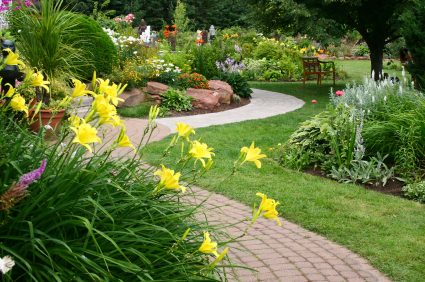Garden Design From a Florist’s Perspective
The garden of her Surrey home is dotted with pots at every turn: some decorative, some functional, some planted and others empty, but all carefully placed for effect.

One year, to welcome winter visitors, Penny planted a pair of clipped standard conifers with a cushion of skimmias beneath, their red berries contrasting cheerfully with the blue glaze of the pots, and placed them at the front door. She didn’t expect the berries to last more than the few weeks of the festivities, but the birds spared them. By June, Penny couldn’t bear to look at her Christmas trees any longer, still massed with berries, and moved the pots into the wings for another year.
The garden is very much Penny’s own, and her husband is modest about his efforts. “Penny does 98 per cent of the work,” he says. “He exaggerates his contribution,” Penny retorts. In fact, she cites “Maurice with his secateurs” as the biggest pest in the garden.
A Talent for Arranging
Penny is a florist, and wherever there is a table in the garden, it is dressed by an arrangement, such as the shallow wire basket, which fills a table in the yard outside the kitchen. “Normally I plant this with blowzy trailing things,” Penny tells, “and every year the basket ends up completely obscured. This year I was determined to see it, so echeverias are perfect – the flowers trail slightly to soften the edges, but they don’t have rampant foliage spilling over.”
But this arrangement is too big when the table is in use, so Penny substitutes soft mounds of Selaginella moss. “They need to be kept wet, but I think they’re much nicer than mind-your-own-business – they have more guts!” she chuckles.
Some of her favourite pots for the table are the wide terracotta saucers Penny fills with low-growing things. One brims over with the tiny white flowers of Campanula ‘Elizabeth Oliver’. “It’s very pretty,” says Penny, “but a nightmare to deadhead, because you end up removing new shoots as well. It’s so fiddly.”
Another is planted with tiny ferns, “like the ones that grow in stone walls in the Lake District”, and mulched with slate. The saucers are perfect for plants like these that need to be kept wet, because they are really designed to go under other pots, so they don’t have drainage holes. However, because they are not glazed, water does gradually evaporate, and nothing gets waterlogged.
The kitchen courtyard is a mass of foliage and flowers, all grown in pots. Ferns, a rose, hostas, fuchsias, a conifer, sage and a manger of ivy fill one corner, with smaller pots defining the other side of a path through the yard. Two bronze cordylines pick out the colour of the brick wall and the rusted metal of a cart hanging above them, and in late summer the orange and yellow flowers of a pot of nasturtiums will add to the theme.
Nasturtiums are usually grown trailing from hanging baskets or sprawling horizontally in borders, but Penny is training her plant up a wigwam. In this tiny yard she maximises height to cram more plants in. Climbers smother the walls, including a clematis, ‘Etoile Rose’, with flowers like pixie hats, and a Cobaea scandens, which bears long pale green bell flowers flushed with purple. “It’s a terrifically vigorous plant,” says Penny, “and more or less grows while you stand and watch it.”
Keep Plants in Happy Pots
Penny uses pots to grow tender plants, which she can overwinter in her conservatory, including the extraordinary yellow-stemmed Costa Rican bamboo, which stands on the terrace. The plant is more than 1.5m (5ft) high and practically all trunk. Maurice loathes it, but Penny was captivated by its colour and planted it in a contrasting blue glazed pot to show it off to best effect.
She also uses containers to grow varieties which she has failed with in the soil. Yellow and pink corydalis thrive in the ground, for example, but she can only keep the blue variety, which is her favourite, in a pot.
In the same way, Penny hopes her three-tiered raised sleeper bed of hot coloured plants, such as Kniphofia, Ligularia, Penstemons and Potentilla, will transform its spot in the garden, beneath a tree. “The soil there was hopeless,” Penny recalls, “and it was shaded and dark.” Raising the plants in the bed increases their chances of getting some light but, more importantly, Penny filled the railway sleeper framework with leaf-mould to give the plants all the nutrients they need.



